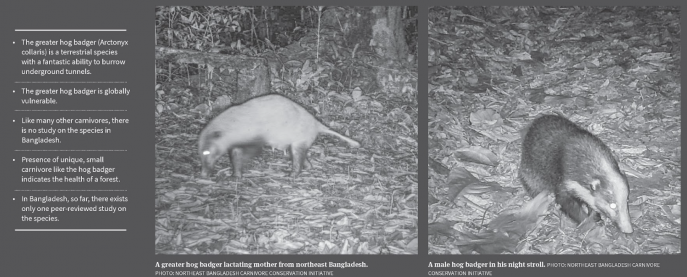The greater hog badger, cornered by a hunting-driven extinction crisis
This fearless carnivore lives a secretive life and digs fantastic tunnels — but that cannot protect them from poachers

HIGHLIGHTS
-
The greater hog badger is globally vulnerable
-
Like many other carnivores, there is no study on the species in Bangladesh
-
Presence of unique, small carnivore like the hog badger indicates the health of a forest
Badgers are a symbol of grit and gallantry, characterised by their rare ability to hold ground when confronted by a larger threat — be it anthropogenic or competition from other predators.
The greater hog badger, a small Asian carnivore, is no different. But grit can only get it so far: The species is a victim of unchecked poaching and very little is known about its ecology.
Species origin
The greater hog badger (Arctonyx collaris) is a terrestrial species with a fantastic ability to burrow underground tunnels. It may look like a miniature bear, thanks to its stocky build, large head, sturdy legs, grizzled grey to tan brown coat, elongated white face and black facial stripes.
But unlike bears, it has two remarkable features: A pig-like, pinkish snout and massive foreclaws, both evolved to aid in digging and assisting its specialised vermivore (worm-based) diet.
Although they rarely exceed 3 feet (head-to-toe) length, the greater hog badger is the second-largest species of the family Mustelidae, just behind the wolverine (Gulo gulo).
The greater hog badger's primary habitats are undisturbed lowlands and high altitude deciduous or evergreen forests. Both types of ecosystems are decreasing.
The species is currently concentrated in the countries of Southeast Asia and Northeast India. Its presence is suspected in southern parts of China's Yunnan and Guangxi provinces and peninsular Malaysia.
It is deemed extinct in Vietnam. In Bangladesh, the species has between 6 to 8 documented sightings and is assumed to be present only in the dipterocarp-dominated hilly forests of southeast Bangladesh.
The northeastern forests of Bangladesh are traditionally described as 'empty', although this assessment lacks any systematic scientific value. In reality, these forests are unbelievably biodiverse. All 27 of the country's carnivorous species are believed to live there.
A similar claim could be made about the forests in the adjoining states of Indian Meghalaya, Tripura, Manipur etc. Together, the region forms a 'biological blank spot', a major landmass where we lack scientific knowledge of what lives there.
To protect and understand hog badgers, these habitats need immediate conservationist interventions, which should involve thorough research, conservation education programmes and sustainable-yet-strict habitat management.
Current status and threats
Arctonyx collaris has been designated vulnerable across the entire species' range, with a population decline of more than 50% over the past 15 years in Indochina. Because of the sharp, continuous decline of forest habitats, the greater hog badger has also received the endangered designation in Bangladesh.
Along with encroaching and the threat of habitat loss as forests shrink with every passing day, the greater hog badger is also severely troubled in Southeast Asia due to hunting, illegal trade and unchecked snaring practices.
Notable conservation programmes
Countries of Southeast Asia are working to stem the tide of the snaring crisis, which will eventually benefit the greater hog badger. However, there is practically no other concerted effort to conserve the species.
In Bangladesh, it is protected by the Wildlife (Conservation and Protection) Act. But in the country so far, there exists only one peer-reviewed study on the species.
The Northeast Bangladesh Carnivore Conservation Initiative has been working since 2018 to bring hog badgers and similar endangered, little-known carnivores into the conservationist limelight.
My personal experience
On 2 January 2021, I was trekking through a trans-border forest in northeast Bangladesh - part of a reconnaissance survey to identify potential camera-trap stations to be deployed in the later months - when I came across some unusual footprints on a sand-bedded stream.
The heel pad was wider than it was long and jutted outward in five elongated but blunt toe marks, which, in turn, were trailed by faint claw dents.
It was smaller than a bear footprint but unlike anything I had ever seen before. "Could this be a badger?" I thought to myself, even though the forests of Bangladesh known for badgers are hundreds of miles away from my study site.
Interestingly, back then, it had only been six months since the first discovery of the greater hog badger from Tripura, the Indian state neighbouring and separating my study area from the south-eastern forests of Bangladesh. So, I clung to the possibility and followed the way of the badger.
On 25 April 2021, a greater hog badger popped up at one of the camera stations! They had never been described in this region before, although the forests of northeast Bangladesh, the western cusp of Indo-Burma hotspots for the species, have suitable characteristics similar to known hog badger habitats.
Later, two more of my camera-trapping stations turned positive for hog badgers. My memories of badger footprints and the photographic discovery fortify my love for the fantastic beasts, which call the north-eastern forests home.




 Keep updated, follow The Business Standard's Google news channel
Keep updated, follow The Business Standard's Google news channel
















